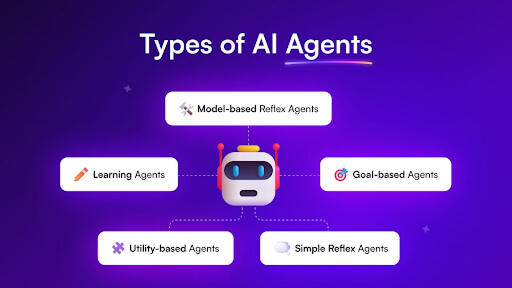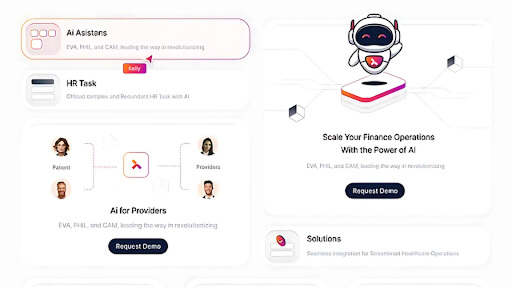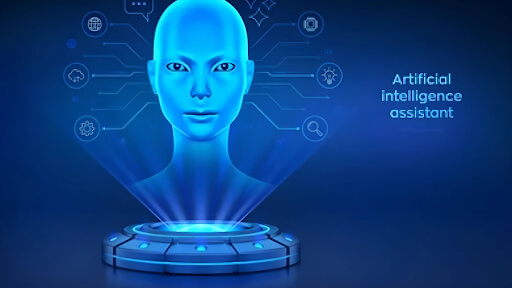 1-800-805-5783
1-800-805-5783 
AI agents are present everywhere, including on your phone, browser, and smart home devices. But what exactly are they? More importantly, how do different types of AI agents work, and how can you use them?
If you’re just getting started with AI, this guide breaks down the types of AI agents, with examples you’ll recognize.
Before diving into the types of AI agents, let’s start with the basics.
An AI agent is a system or entity that perceives its environment through sensors and acts upon that environment using actuators to achieve a specific goal. In simple terms, an AI agent is like a digital decision-maker: it sees, thinks, and acts.
A good real-world analogy? Imagine a robotic vacuum cleaner:
This combination of perception, decision-making, and action is what makes it an intelligent agent.

AI agents are the building blocks of many modern technologies. Whether it’s a chatbot helping you with a refund, an autonomous drone navigating terrain, or a stock trading bot analyzing market trends, AI agents are everywhere.
By learning about the different types of agents in AI, you gain valuable insight into how systems make decisions, adapt, and solve problems in a wide range of industries.
There are five fundamental types of AI agents, categorized by their complexity and intelligence. Whether you’re a student, developer, or enthusiast, understanding these types is key to navigating the AI landscape.
Key Idea: Reacts solely to the current input without memory.
How it works: These agents follow a strict condition-action rule. For every input, there’s a predefined response.
Example:
Pros:
Cons:
This is the simplest type of agent in AI, ideal for systems with predictable conditions.
Key Idea: Maintains a basic internal model to track changes in the environment.
How it works: These agents can handle partially observable environments by remembering past percepts or states.
Example:
Pros:
Cons:
If you’re exploring types of AI agents with examples, this one bridges the gap between rule-following and slightly adaptive behavior.

Key Idea: Actions are guided by a defined goal.
How it works: These agents evaluate potential future states and select the best action to achieve a goal.
Example:
Pros:
Cons:
This is one of the most popular types of AI agents in goal-driven applications, such as robotics, navigation, and gaming.
Key Idea: Aims to maximize a utility (benefit) function, not just reach a goal.
How it works: These agents assess how “desirable” each possible outcome is and pick the one with the highest utility.
Example:
Pros:
Cons:
When comparing the different types of AI agents, this one stands out for its use in environments that require evaluation, not just goal achievement.
Key Idea: Learn from past experiences to improve performance.
How it works: These agents continuously update their knowledge or strategy based on feedback from the environment.
Example:
Core components:
Pros:
Cons:
These are the most advanced types of AI agents, with examples, and are essential in AI applications such as recommendation engines and autonomous systems.

| Type | Memory | Goal-Oriented | Learns | Complexity |
|---|---|---|---|---|
| Simple Reflex Agent | ❌ | ❌ | ❌ | Low |
| Model-Based Reflex Agent | ✅ | ❌ | ❌ | Medium |
| Goal-Based Agent | ✅ | ✅ | ❌ | Medium |
| Utility-Based Agent | ✅ | ✅ | ❌ | High |
| Learning Agent | ✅ | ✅ | ✅ | Very High |
Understanding the types of agents in AI can help you determine which model is best for your specific AI problem, whether you’re building a chatbot, robot, or intelligent assistant.
Let’s bring this closer to home with some real-world examples:
Choosing the right AI agent depends on several factors:
For example:

AI agents are at the heart of modern automation, personalization, and decision-making. As you begin your journey into AI, understanding the different types of AI agents helps you appreciate how machines make choices, some simple, others stunningly complex.
Whether it’s a basic rule-following bot or a brilliant learning system, every AI agent is designed with one thing in mind: to make decisions in the best possible way.
Now that you know the basics, the next step is up to you to experiment, explore, and even build one of your own.
1. What are the types of AI agents?
There are five main types: simple reflex, model-based reflex, goal-based, utility-based, and learning agents.
2. Which AI agent is used for personalization?
Learning agents adapt over time and are ideal for recommendation systems like Netflix.
3. Is a utility-based agent better than a goal-based one?
Utility-based agents optimize outcomes, while goal-based agents just achieve objectives. It depends on your needs.
4. Can AI agents be combined?
Yes, many systems utilize hybrid agents to achieve better performance and flexibility.
At [x]cube LABS, we craft intelligent AI agents that seamlessly integrate with your systems, enhancing efficiency and innovation:
Integrate our Agentic AI solutions to automate tasks, derive actionable insights, and deliver superior customer experiences effortlessly within your existing workflows.
For more information and to schedule a FREE demo, check out all our ready-to-deploy agents here.